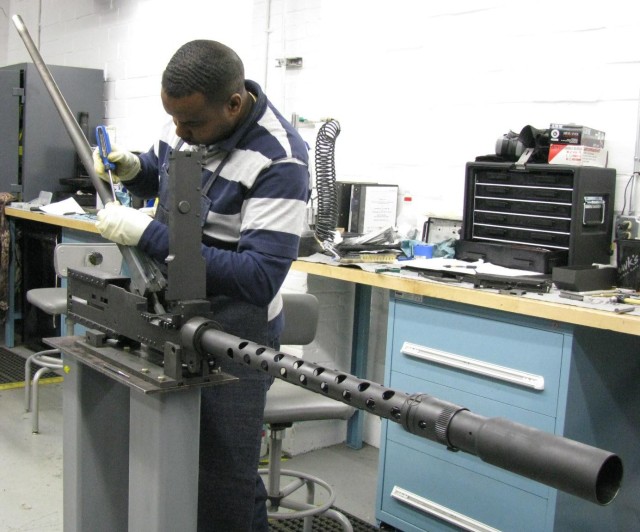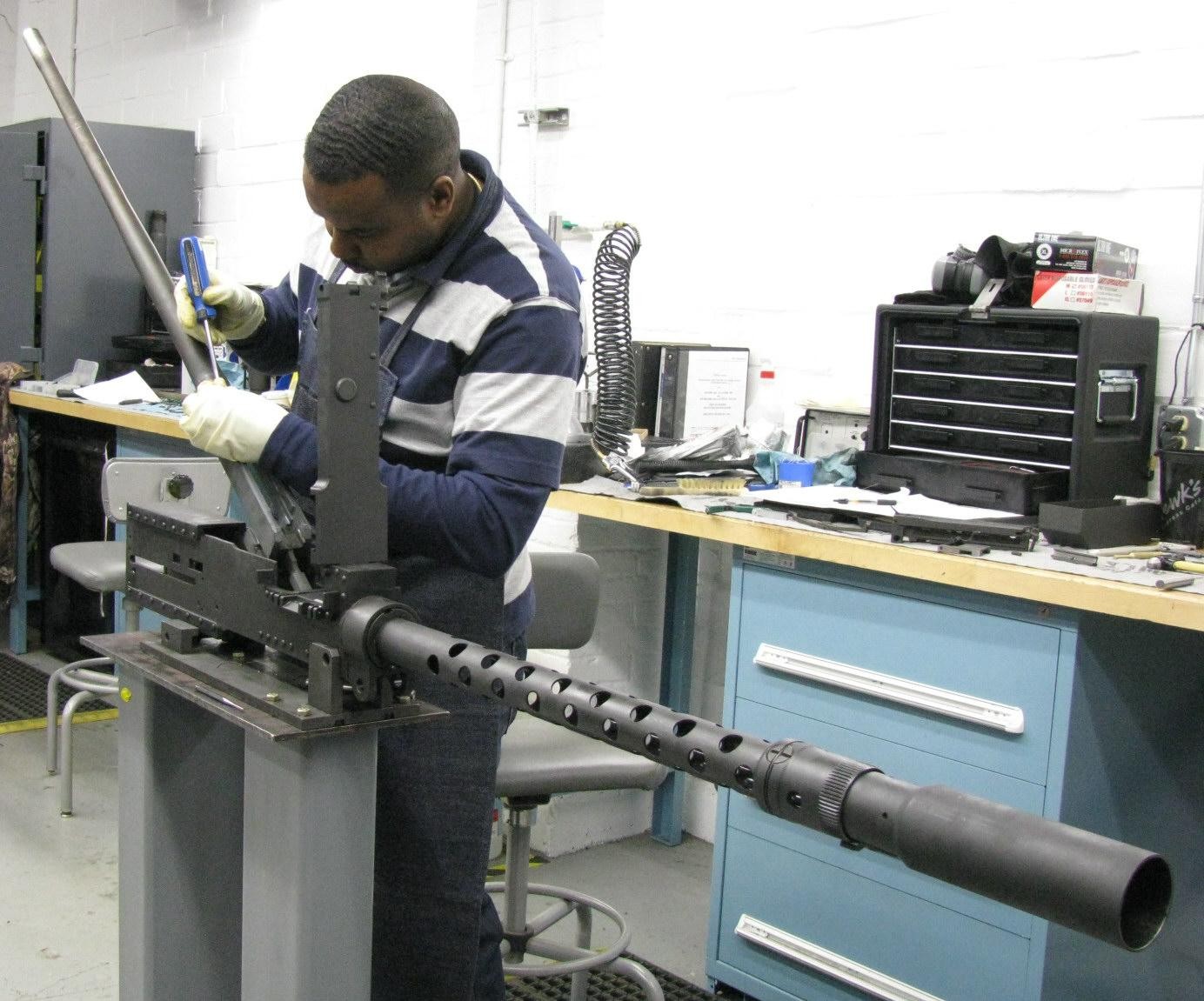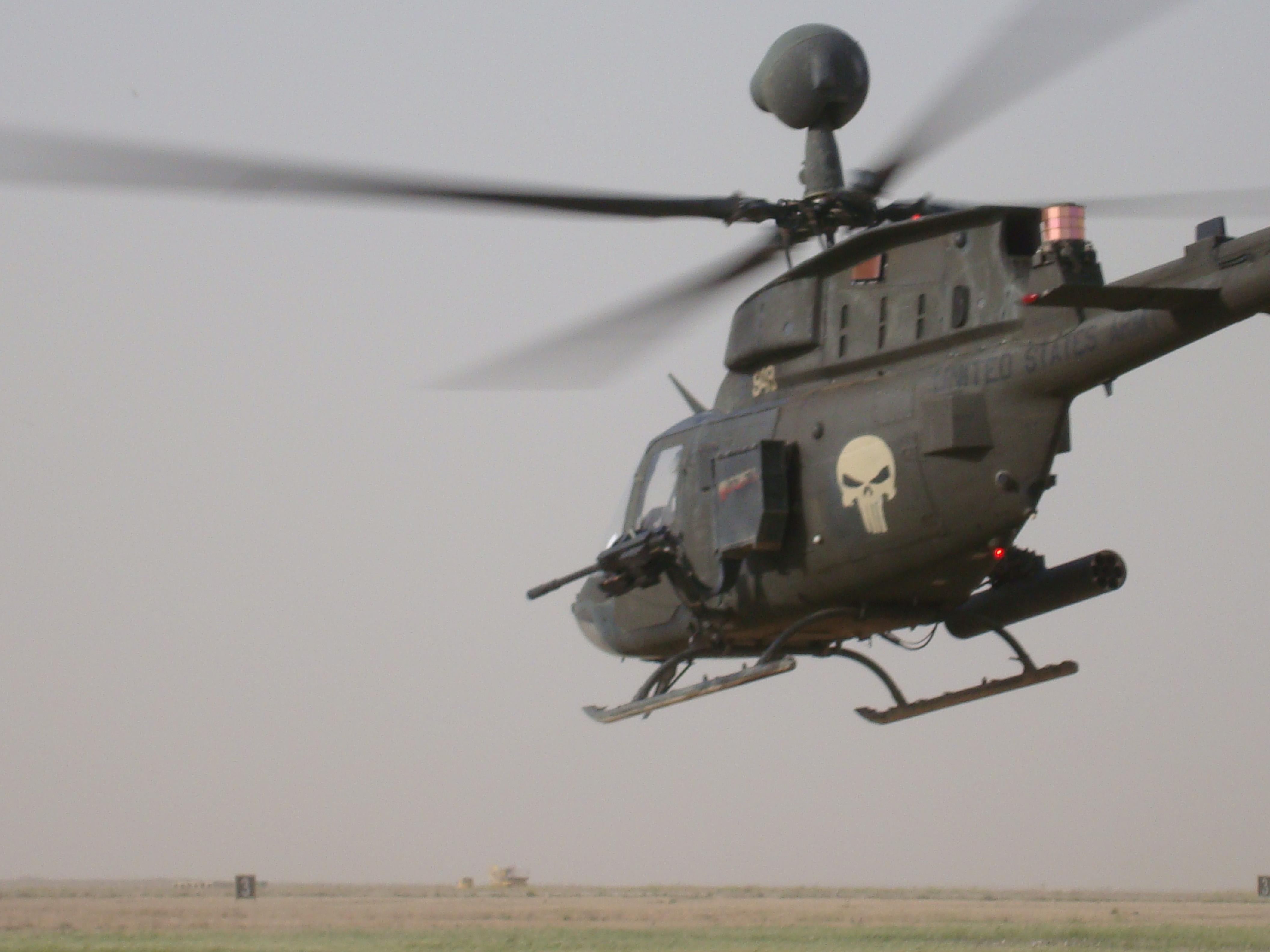The Army's Avenger air defense system is not part of the firefight these days in overseas contingency operations in Iraq and Afghanistan. But its machine gun - the M3P .50 caliber - is gaining rave reviews from Army pilots thanks to a new application developed by AMCOM and Program Executive Office for Aviation workers.
In recent months, Avenger's M3P machine gun has taken on a new life as the machine gun of choice for OH-58D Kiowa Warrior units stationed in Iraq and Afghanistan. The M3P is providing Kiowa units with what they needed as outlined in two Operational Needs Statements from theater - a lightweight, reliable gun system with a level of lethality greater than or equal to the helicopter's previous XM296 machine gun and a machine gun more suited for close fighting situations encountered in urban environments.
"This is a success story in that we were able to respond quickly to a need in theater with a system that we already had in our inventory," said Maj. Kirk McCauley, assistant product manager for Kiowa Warrior, PEO for Aviation.
"It speaks to the level of talent and expertise we have here at Redstone Arsenal. Employees brought their experience and know how to the table and came up with a simple, elegant and effective solution that used internal and inexpensive resources to provide exactly what we needed in record time."
The use of the M3P machine gun on Kiowa helicopters represents an innovative and can-do approach by a team of several Army entities, including AMCOM' s Maintenance Operations Procedures and Prototype facility (MOPP Shop); PEO for Missiles and Space's Cruise Missile Defense System Project Office, PEO for Aviation's Kiowa Warrior Product Office; Redstone Technical Test Center; Aviation Technical Test Center; Prototype Integration Facility; and Fort Stewart, Ga., and Fort Campbell, Ky.
Although the need for a more effective and reliable machine gun for the Kiowa helicopter wasn't submitted in an Operational Needs Statement until May 2007, the MOPP Shop had been working on ways to reuse Avenger M3P machine guns since 2004.
When the 7th of the 17th Cavalry submitted the ONS for a new .50 caliber machine gun, the Kiowa product office team and the TRADOC capabilities manager at Fort Rucker investigated several solutions, identifying M3P as one of the best solutions.
The M3P, with its 1,100-round-per-minute rate of fire, ability to penetrate lightly armored vehicles and an effective range of 1,500 meters, quickly became the most viable option for the Kiowa helicopter and the MOPP Shop took the lead on integrating it to the Kiowa helicopter system.
"When you get an Operational Needs Statement from a commander in theater it goes on a fast track," McCauley said. "It means we have a deficiency need that has to be filled quickly. This ONS said the machine gun on the Kiowa helicopter was inadequate and unreliable, and that an alternative was needed. The old gun was so unreliable that it became known as a 'one-shot wonder' and totally unsuitable for the Kiowa's scout mission. The ONS went directly to the Pentagon."
At the time the M3P was being considered for a solution for the Kiowa, the Army's decision to reduce the total number of fielded Avenger air defense systems made it an available alternative.
"The Avenger system was being phased out because there is no current air threat," McCauley said. "They were being turned in and some 800 guns were being taken off and put in storage.
"The guns were in various stages of readiness. But they were also government-owned. Instead of developing something new, we decided to take a proven system and adapt it and save money."
Once the machine gun was chosen, it needed a mounting system (platform) that would attach it to the Kiowa helicopter. The MOPP Shop competed with two military contractors in developing a mounting system.
"As work on a firing platform progressed, it became apparent to us that we weren't so sure that the military contractors would have the platform that was needed for the job," said Gary Henry, chief of the MOPP Shop's Sustainment Support Division, Integrated Materiel Management Center.
"Through a combined effort, we came up with a platform to mount the gun on the Kiowa's universal weapons pylon. Our platform design is solely based on the talents of the guys in our machine shop. Without that platform, our gun would not have been selected."
The Kiowa's M3P system uses the existing Kiowa Warrior ammo can, the Avenger feed chute and a simple, lightweight mount designed by the MOPP shop. The new mount attaches the M3P directly to the Universal Weapons Pylon (UWP) and eliminates a cumbersome gun cage assembly.
Test data from fielding with the 7/17th showed that the MOPP Shop's mount and gun system was durable, reduced the noise level by 48 percent and dropped the weight of the system by 65 pounds.
"The loss of weight was a big plus because it means you can put more gas or more ammunition in the helicopter," Bill Cannon of the MOPP Shop said.
"Every pound saved reduced the cost by $20,000 per pound over the life of the helicopter," added Ron Bridges of the MOPP Shop. "We increased reliability in combat with rebuilt guns from the Avenger."
In addition, the gun is positioned higher up, more forward and further out than the older system, reducing blast pressure effects on the helicopter fuselage and resulting in less noticeable noise for the pilot. It is also easier to remove from the pylon, making it more accessible for loading, maintaining and troubleshooting.
To ensure the guns performed flawlessly in theater, Staff Sgt. Jim Journigan and Joe Lane from the Kiowa Warrior Product Office led teams of subject matter experts to deliver, install and train personnel on the operation of the new weapons on site at each location in Iraq and Afghanistan.
"Transportation in a combat zone is not routine. The fielding teams had a significant challenge delivering this equipment to multiple remote locations in both Iraq and Afghanistan. We relied heavily on their resourcefulness to make mission, and they did not disappoint," McCauley said.
So far, 130 M3P machine guns have been fielded in theater. A total of 380 guns will be fielded to supply the entire fleet of Kiowa helicopters. Plans are also going forward to supply a Tennessee National Guard unit with the new gun system.
Since mid-January, 30 M3P guns used on Kiowa helicopters in theater have fired more than 100,000 rounds of ammunition.
"The report from theater is there are no gun problems now with Kiowa helicopters that have the M3P," Bridges said. "Pilots come back raving how accurate it is and how dependable it is."
Cannon, Dennis Bayless and Ricky Davis, all from the MOPP Shop, have also traveled to Iraq and Afghanistan to provide training on the M3P machine gun to both maintenance personnel and pilots.
"We had to make sure the pilots knew what to expect because the rate of fire is so much higher with the M3P," Cannon said. "The old machine gun had a rate of fire of 700 rounds per minute. The M3P has a rate of fire of 1,025 to 1,100. That's 18 rounds per second."
The machine gun is now so popular that PEO for Aviation is facing a new problem - adding an uptempo to the gun's maintenance requirements.
"There is a new demand on parts and maintenance for these guns that we have to support," McCauley said.
"We are reusing mechanical parts from the Avenger systems. But we also have to establish a source for future parts. The Cruise Missile Defense System office is working on a long-term source for parts and repairs. Logistical support for the system has grown and now there is a need for the logistical tail to make this program successful for the long term."
McCauley said the teamwork from all the Army organizations involved with the Kiowa Warrior machine gun solution resulted in getting a more effective weapon system into the hands of Kiowa helicopter pilots in record time.
"We were able to work quickly on getting the new gun system fielded because of the close proximity of Fort Campbell, Redstone Arsenal and Fort Rucker. That proximity allowed increased face-to-face coordination and provided increased ability to adapt to the inevitable integration issues," McCauley said. "Fred Alcorn from the Kiowa Warrior Product Office and the team from the MOPP Shop worked on site at Fort Rucker's Molinelli Range to smoothly execute flight testing.
"But even more important was that the co-location of the Kiowa Warrior Product Office with Redstone Arsenal's design, test and air worthiness organizations significantly enhanced coordination and support of the war fighter in theater."




Social Sharing